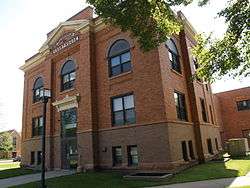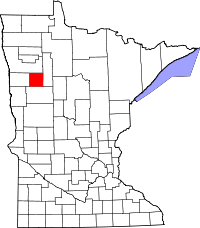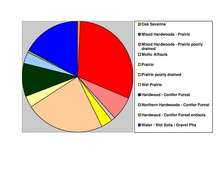Mahnomen County, Minnesota
| Mahnomen County, Minnesota | |
|---|---|
 | |
 Location in the U.S. state of Minnesota | |
 Minnesota's location in the U.S. | |
| Founded | December 27, 1906[1] |
| Named for | Ojibway word for wild rice[2] |
| Seat | Mahnomen |
| Largest city | Mahnomen |
| Area | |
| • Total | 583 sq mi (1,510 km2) |
| • Land | 558 sq mi (1,445 km2) |
| • Water | 25 sq mi (65 km2), 4.3% |
| Population (est.) | |
| • (2015) | 5,457 |
| • Density | 9.7/sq mi (4/km²) |
| Congressional district | 7th |
| Time zone | Central: UTC-6/-5 |
| Website |
www |
Mahnomen County (/məˈnoʊmən/ mə-NOH-mən) is a county located in the U.S. state of Minnesota. As of the 2010 census, the population was 5,413.[3] Its county seat is Mahnomen.[4]
The entire county is part of the White Earth Indian Reservation.[5] It is the only county in Minnesota entirely within an Indian reservation. The county, along with East Polk and Becker County, are one of the biggest cattle-raising areas in the northwestern part of Minnesota.
Geography
According to the U.S. Census Bureau, the county has a total area of 583 square miles (1,510 km2), of which 558 square miles (1,450 km2) is land and 25 square miles (65 km2) (4.3%) is water.[6] Mahnomen is one of 17 Minnesota savanna region counties with more savanna soils than either prairie or forest soils.

Major highways
Adjacent counties
- Polk County (north)
- Clearwater County (east)
- Becker County (south)
- Norman County (west)
Demographics
| Historical population | |||
|---|---|---|---|
| Census | Pop. | %± | |
| 1910 | 3,249 | — | |
| 1920 | 6,197 | 90.7% | |
| 1930 | 6,153 | −0.7% | |
| 1940 | 8,054 | 30.9% | |
| 1950 | 7,059 | −12.4% | |
| 1960 | 6,341 | −10.2% | |
| 1970 | 5,638 | −11.1% | |
| 1980 | 5,535 | −1.8% | |
| 1990 | 5,044 | −8.9% | |
| 2000 | 5,190 | 2.9% | |
| 2010 | 5,413 | 4.3% | |
| Est. 2015 | 5,457 | [8] | 0.8% |
| U.S. Decennial Census[9] 1790-1960[10] 1900-1990[11] 1990-2000[12] 2010-2015[3] | |||

As of the census of 2000,[13] there were 5,190 people, 1,969 households, and 1,366 families residing in the county. The population density was 9 people per square mile (4/km²). There were 2,700 housing units at an average density of 5 per square mile (2/km²). The racial makeup of the county was 62.85% White (3,262 people) 0.13% Black or African American (7 people), 28.55% Native American (1,482 people), 0.06% Asian (3 people), 0.31% from other races (16 people), and 8.09% (420 people) from two or more races. 0.89% of the population (46 people) were Hispanic or Latino of any race. 29.4% (1525 people) were of German and 17.0% (882 people) Norwegian ancestry.
There were 1,969 households out of which 32.40% had children under the age of 18 living with them, 51.60% were married couples living together, 11.60% had a female householder with no husband present, and 30.60% were non-families. 27.00% of all households were made up of individuals and 14.90% had someone living alone who was 65 years of age or older. The average household size was 2.60 and the average family size was 3.14.
In the county the population was spread out with 29.20% under the age of 18, 7.20% from 18 to 24, 23.50% from 25 to 44, 23.40% from 45 to 64, and 16.70% who were 65 years of age or older. The median age was 38 years. For every 100 females there were 102.90 males. For every 100 females age 18 and over, there were 98.40 males.
The median income for a household in the county was $30,053, and the median income for a family was $35,500. Males had a median income of $23,614 versus $21,000 for females. The per capita income for the county was $13,438. About 11.80% of families and 16.70% of the population were below the poverty line, including 21.30% of those under age 18 and 15.30% of those age 65 or over.
Communities
Cities
Townships
Census-designated places
Unincorporated community
See also
- National Register of Historic Places listings in Mahnomen County, Minnesota
- USS Mahnomen County (LST-912)
References
- ↑ "Minnesota Place Names". Minnesota Historical Society. Retrieved March 18, 2014.
- ↑ Upham, Warren (1920). Minnesota Geographic Names: Their Origin and Historic Significance. Minnesota Historical Society. p. 321.
- 1 2 "State & County QuickFacts". United States Census Bureau. Retrieved September 1, 2013.
- ↑ "Find a County". National Association of Counties. Retrieved 2011-06-07.
- ↑
- ↑ "2010 Census Gazetteer Files". United States Census Bureau. August 22, 2012. Retrieved October 21, 2014.
- ↑ Nelson, Steven (2011). Savanna Soils of Minnesota. Minnesota: Self. pp. 53 - 56. ISBN 978-0-615-50320-2.
- ↑ "County Totals Dataset: Population, Population Change and Estimated Components of Population Change: April 1, 2010 to July 1, 2015". Retrieved July 2, 2016.
- ↑ "U.S. Decennial Census". United States Census Bureau. Retrieved October 21, 2014.
- ↑ "Historical Census Browser". University of Virginia Library. Retrieved October 21, 2014.
- ↑ "Population of Counties by Decennial Census: 1900 to 1990". United States Census Bureau. Retrieved October 21, 2014.
- ↑ "Census 2000 PHC-T-4. Ranking Tables for Counties: 1990 and 2000" (PDF). United States Census Bureau. Retrieved October 21, 2014.
- ↑ "American FactFinder". United States Census Bureau. Retrieved 2008-01-31.
External links
 |
Polk County |  | ||
| Norman County | |
Clearwater County | ||
| ||||
| | ||||
| Becker County |
Coordinates: 47°20′N 95°49′W / 47.33°N 95.81°W